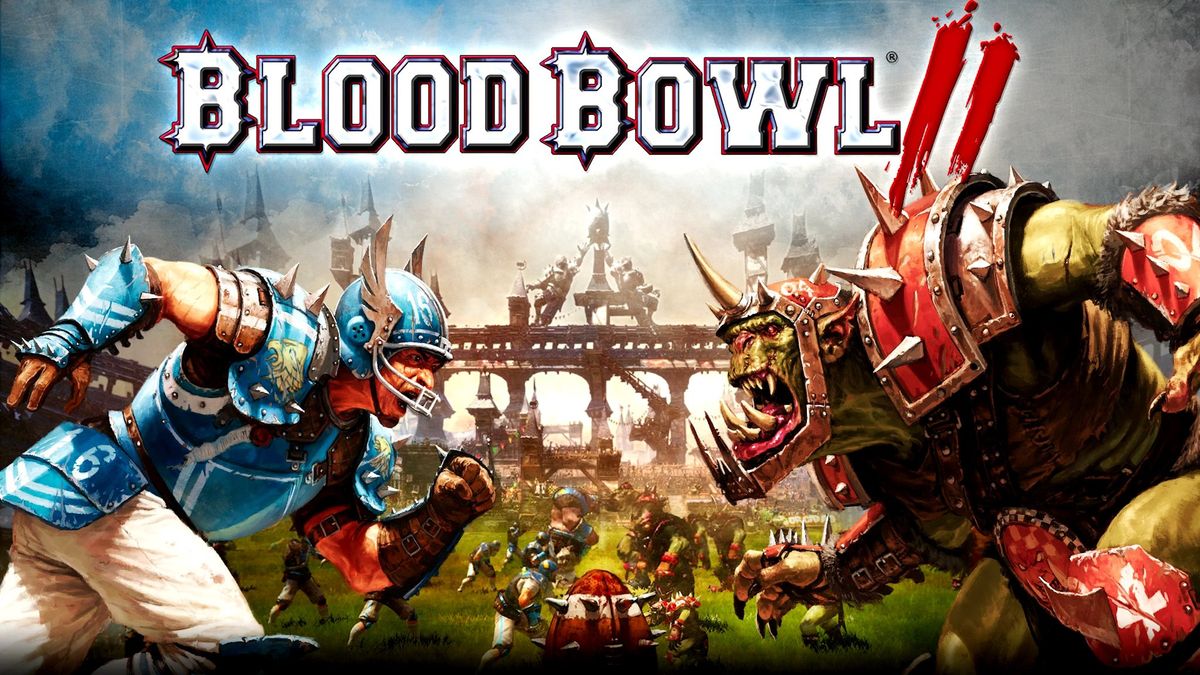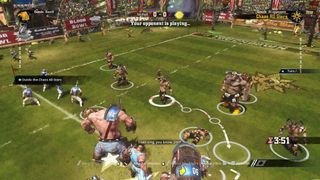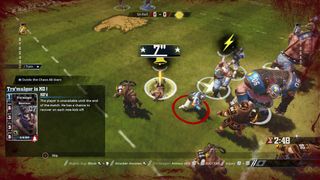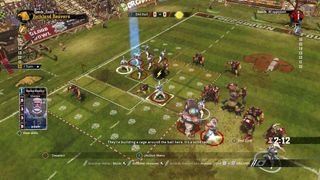Blood Bowl 2 in-depth review: Sports, strategy, and fantasy collide on Xbox One and PC

Sports games come in two basic flavors: simulation and arcade. But what if there was a third option? French developer Cyanide Studio and publisher Focus Home Interactive have made that happen.
Blood Bowl 2 for Xbox One, Steam, and PlayStation 4 takes a completely different approach than typical sports games. Players select from a variety of fantasy teams and compete in a football-like sport. But this one plays like a turn-based strategy game, with each side taking separate turns and dice rolls determining the outcomes of each action.
Will sports fans or strategy fans cheer for Blood Bowl 2? Read our detailed review to find out!
Talk about fantasy football
Blood Bowl is a fantasy sport set within a darkly comedic version of the Warhammer universe. In this world, teams of 11 players consisting of humans, orcs, dwarves, elves, and other races meet on the gridiron and battle for victory – sometimes to the death. The sport itself closely resembles American Football, though it differs in several ways.
Each game begins with a coin toss, followed by a kick-off. The offensive team attempts to run or pass the ball to the end zone, whereas the defensive team tries to stop them. If a team succeeds in scoring, they get a single point and then have to kick the ball back to the former defenders.
While Blood Bowl clearly uses American football as its foundation, it simplifies several rules in order to streamline gameplay. For instance, the team on offense can't punt or score extra points. Each team can score a maximum of one point per turn.

Instead of breaking turns up into downs, a turn continues until either every player on the team has moved and/or performed an action, a turnover occurs, the human/AI player decides to end the turn, or the turn timer expires. I like not having to worry about downs – you just achieve as much as you can during your turn, and then the other guy gets to do the same.
Get the Windows Central Newsletter
All the latest news, reviews, and guides for Windows and Xbox diehards.
And rather than lasting for a set duration of time, the game consists of 16 total turns per team. After both teams complete their first eight turns, a brief halftime show occurs. Both teams' positions on the field get reset at that point, and knocked out or injured players can sometimes return to the field. But just because Blood Bowl games only give each team 16 turns, don't expect games to be over quickly. They typically last anywhere from 1-2 hours, because this is also a strategy game.

Sports strategy
During your team's turn, you can initiate a variety of actions with your players, including moving, blocking (tackles and pushes), fouls (hitting a downed opponent), picking up the ball, and passing. Most players who move can't block during the same turn. But you do get one Blitz action per turn, which allows a single player to both move and block during that turn.
Moving players is simple enough – each player has a movement range based on his position, species, and level. The movement range includes a safe distance within which the player can move without the need for a die roll. The player can also move at least two spaces beyond the safe range by "Going For It." Each of these "GFI" spaces requires a successful die roll, adding some risk to going for that extra yardage. Fail the die roll and the player falls over, causing a turnover.
Movement also carries a risk when an opposing team member stands adjacent to the player who tries to move. While the enemy can't directly attack you during your turn, adjacent opponents have a chance to knock the moving player down, leading to a turnover. Whether the player succeeds in moving away from an adjacent opponent is of course decided by dice rolls.

The "Blood" in Blood Bowl mostly comes from blocks – attacks against enemy players. During your turn, you can command any member of your team to attack an adjacent opponent. A number of factors determine the likelihood of success, including each member's strength rating and the proximity of other teammates. Adjacent teammates provide a strength bonus to attackers and defenders.
Depending on those strength calculations, the attacker gets to roll 1-3 dice to determine the outcome of the attack. If the dice appear in red before you roll, then that means the defender gets to pick which of the rolled dice actions will actually happen – so you usually want to just avoid attacking with red dice. Why the dice are red sometimes but not others, I don't know – some formula, surely.
The face of each die represents a possible outcome of the move. These can result in the defender getting tackled, the defender getting pushed back one space, the attacker getting knocked down, or both players falling down. You'll normally pick the best outcome from the die faces. If your attacker goes down while attempting an attack, a turnover happens, and your turn ends.

Attacking players successfully knocks them down and has the chance to stun them (making them stay down for an extra turn), knock them out (taking them off the field until halftime or the remainder of the game), injure them (temporarily or permanently reducing stats), or even kill them.
Players can level up in Blood Bowl and gain useful new skills, so permanently losing a player usually hurts pretty badly! Also, any knocked out, injured, or dead player can only be replaced at halftime, so your team can end up with way less than 11 players on the field if things go poorly.
The normal result of a knockdown is that the player must be stood up during that team's next turn, preventing him from moving or attacking in that turn. The controls for standing a player up are a bit cumbersome – you have to select the player with A, hit X for the action menu, and then hit A on 'Stand up.' This gets even more annoying when you have to stand up several players in one turn. The game really needs the ability to stand all downed players up in one action.

Campaign of Cruelty
If Blood Bowl 2's gameplay sounds complex, at least the game eases you into things gradually. Over the course of the 14-game campaign, new rules and mechanics are gradually introduced to the player. For instance, you won't have to worry about player deaths or turn timers early on. Eventually, you'll be limited to four minutes per turn (which is fairly generous).
The campaign is both the best and worst aspect of Blood Bowl 2. It features an actual fully voiced story that develops before and after every game – something you just don't see in most sports video games. Most of the narrative comes from the two commentators, a hulking ogre and a diminutive vampire. Even though everything happens either in the sole studio location or on the field, the story ends up pretty interesting thanks to witty writing and lots of humor.
On the downside, the commentators' cartoonish voices can be irritating at times. And some of their play-by-play lines repeat far too frequently. If I ever hear about getting "so close you can see the bugs in their teeth" or "the famous story of 'Nurgling and the Great Unclean One'" again, it'll be too soon. An algorithm to prevent lines from repeating during the same game would ease the repetition.
The real problem with Blood Bowl 2's campaign, though, is its difficulty – and that goes for single-player League games outside of Campaign as well. See, you can play as strategically as you like, but the outcome of every action comes down to one or more dice rolls. When those dice go against you, you might find your turn ending before you even accomplish anything. Or worse, you could lose a player temporarily or permanently.

Owing so much of your fate to the dice works fine in a real-life board game setting against another player, or even during Blood Bowl 2's online multiplayer games. When I play a one-on-one game against another person, I don't expect to win every time. But when I go up against the computer in a campaign, I actually do want the win!
Campaign games last a minimum of one hour, and I've had them go all the way to four hours. You get absolutely nothing for losing, so imagine the frustration of losing a campaign game after one or more hours. Not fun and the Xbox One version's excessive loading times at start-up and before each game don't help.
Cyanide could reduce the frustration factor in some ways. Really, all three of these would improve the game in tandem:
- Add a difficulty selection for single-player games! Let us make it as easy or hard as we want.
- Let players earn rewards even when they lose single-player games. Don't waste our time spent playing against the harsh computer.
- Allow players to save and resume games at any time. We can currently 'Save and Quit,' but you lose the save upon resuming (unless you know a trick we'll share shortly). That way, we needn't be so beholden to unfortunate dice rolls.

The Save and Quit Trick
Normally, you can only resume a save once after choosing to Save and Quit. But having resumed the save, you can then push the Home/Guide button and kill the game from the dashboard. You can then resume your mid-game save as many times you want – it sticks around until the next time you Save and Quit.
The strategy to build from this is saving every time anything particularly good happens for your team, such as an enemy player getting KOed or Injured, scoring a point, or completing a mid-match objective (like getting a Foul or Pass). Also just save periodically after that, usually at the beginning of your turn.
Whenever anything bad happens like an early Turnover on your turn or one of your players getting knocked out, you can just dashboard, kill the game, and resume your last save.
The downside to this Save and Quit strategy is that it's very time-consuming! You have to go through several minutes of loading time just to dashboard and resume. But it's better than losing hours of time on a lost game, and the campaign would be nearly impossible at times without the technique.
Once again, the developer could improve the save feature and save us all a lot of time and trouble.

Team Management, Leagues, and Multiplayer
Outside of the punishingly difficult but still entertaining campaign, Blood Bowl 2 also offers strong team creation and league features. The actual visual customization of your players is rudimentary, but building and balancing a team and then leveling up your players over time can be truly satisfying.
Long-term appeal comes from participating in single-player or multiplayer leagues with your custom teams. We don't have room to go into depth about Leagues, but I will say the multiplayer league features are fairly robust. A group of like-minded Blood Bowl players can create a league, track everyone's progress, trade players, and much more.
Blood Bowl 2 supports local and online multiplayer. I didn't try local, but the online multiplayer is super fun. You'll generally want to pick pre-made teams of similar strength, but you could also just mash your custom teams against each other to see who comes out on top. Talk even one friend who likes strategy and/or board games into picking up this game and you'll both gets tons of hours out of competing together.

Achievements
The Xbox One version of Blood Bowl 2 has 30 Achievements worth 1,000 Gamerscore. At eight games and many hours into the campaign, I only have nine of them. Several require random or extremely challenging conditions to be met during single-player games – most players will never get those.
Nobody has completed Blood Bowl 2's Achievements yet, but hopefully more guides will trickle out over time. Just don't buy this one for the Achievements.

Rough but rewarding
Blood Bowl 2 is a tough game to recommend. By its very nature as a sports-strategy game, this was always going to be a niche product. But the developers also made the single-player game sadistically hard, seemingly unaware of the potential for frustration. So you have to like sports, strategy, and being kicked in the junk to really get into this one.
On the other hand, if we ignore the difficulty issues or rely on the tedious Save and Quit Trick, the game can be so rewarding. Mechanically, Blood Bowl 2 is a fantastic adaptation of the board game (other than not being able to stand all players up at once). I don't care for traditional sports simulations, but the strategic gameplay and fantasy theme totally hit home for me. Even as I write, I wish I was playing it.
Hopefully, Cyanide Studios will update Blood Bowl 2 over time to ease up its difficulty. All the clever gameplay mechanics and production values in the world don't matter if half the people who try your game give up over its punishing difficulty.
This review conducted on Xbox One with a review copy provided by the publisher.
Paul Acevedo is the Games Editor at Windows Central. A lifelong gamer, he has written about videogames for over 15 years and reviewed over 350 games for our site. Follow him on Twitter @PaulRAcevedo. Don’t hate. Appreciate!
